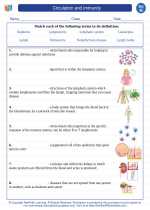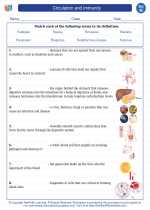Commensalism
Commensalism is a type of symbiotic relationship between two organisms where one organism benefits while the other is neither helped nor harmed. In this relationship, one organism, called the commensal, benefits by obtaining food, shelter, support, or other resources, while the other organism, called the host, is not significantly affected.
Examples of Commensalism:
- Remora fish and sharks: Remora fish attach themselves to sharks and feed on the leftovers from the shark's meals without harming the shark.
- Orchids and trees: Orchids grow on the branches of trees, using the trees for support and reaching sunlight, while not harming the trees.
- Barnacles and whales: Barnacles attach themselves to the skin of whales, benefiting from the whale's movement through the water while not significantly affecting the whale.
Study Guide:
- Define commensalism and provide an example of this type of relationship in nature.
- Explain the difference between commensalism and mutualism. Provide examples of both types of relationships.
- Discuss the ecological importance of commensalism in maintaining balance within ecosystems.
- Research and describe lesser-known examples of commensalism in different ecosystems, such as marine, terrestrial, and freshwater environments.
- Compare and contrast commensalism with other types of symbiotic relationships, such as parasitism and mutualism.
Understanding commensalism is important for comprehending the complex interactions between organisms in nature and the delicate balance of ecosystems.
.◂Science Worksheets and Study Guides Eighth Grade. Circulation and immunity
Study Guide Circulation and immunity
Circulation and immunity  Worksheet/Answer key
Worksheet/Answer key Circulation and immunity
Circulation and immunity  Worksheet/Answer key
Worksheet/Answer key Circulation and immunity
Circulation and immunity  Worksheet/Answer key
Worksheet/Answer key Circulation and immunity
Circulation and immunity  Vocabulary/Answer key
Vocabulary/Answer key Circulation and immunity
Circulation and immunity  Vocabulary/Answer key
Vocabulary/Answer key Circulation and immunity
Circulation and immunity  Vocabulary/Answer key
Vocabulary/Answer key Circulation and immunity
Circulation and immunity  Vocabulary/Answer key
Vocabulary/Answer key Circulation and immunity
Circulation and immunity  Vocabulary/Answer key
Vocabulary/Answer key Circulation and immunity
Circulation and immunity  Vocabulary/Answer key
Vocabulary/Answer key Circulation and immunity
Circulation and immunity  Vocabulary/Answer key
Vocabulary/Answer key Circulation and immunity
Circulation and immunity 

 Worksheet/Answer key
Worksheet/Answer key
 Worksheet/Answer key
Worksheet/Answer key
 Worksheet/Answer key
Worksheet/Answer key
 Vocabulary/Answer key
Vocabulary/Answer key
 Vocabulary/Answer key
Vocabulary/Answer key
 Vocabulary/Answer key
Vocabulary/Answer key
 Vocabulary/Answer key
Vocabulary/Answer key
 Vocabulary/Answer key
Vocabulary/Answer key
 Vocabulary/Answer key
Vocabulary/Answer key
 Vocabulary/Answer key
Vocabulary/Answer key
